Everything you need to know about Infrared Heating
• Temperatures and Ventilation
• When the temperature is -20 degrees C outside can the temperature inside stay at say 24 degrees C
• Can the thermostat be controlled by an app
• U-values in relation to air changes in a room
• Interesting facts about Infrared Heat
UK Infrared Heating Manual
 If you want everything in one easy place to view, download our UK Infrared Heating Manual and keep it as an easy reference guide.
If you want everything in one easy place to view, download our UK Infrared Heating Manual and keep it as an easy reference guide.
What is Infrared Heat
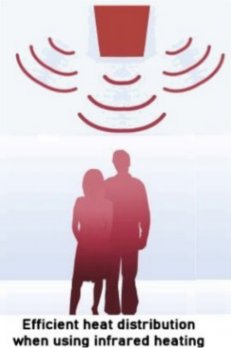 If you want to live healthily and sustainably it is best to reflect on nature and its unique powers. Heat4All takes this as a model and combines experience and science in its high-quality new infrared heaters. Infrared is radiant heat similar to the Sun. It is not convection heat through radiators. It is therefore vastly more efficient and effective as infrared does not heat the air but instead heats people and objects.
If you want to live healthily and sustainably it is best to reflect on nature and its unique powers. Heat4All takes this as a model and combines experience and science in its high-quality new infrared heaters. Infrared is radiant heat similar to the Sun. It is not convection heat through radiators. It is therefore vastly more efficient and effective as infrared does not heat the air but instead heats people and objects.
There are different forms of infrared and it is important to know that proper infrared has to have a temperature exceeding 50oC. Anything less is not infrared. Our panels have a temperature between 90oC and 110oC and that is why, apart from the quality Austrian workmanship, they provide the best quality infrared. Please try to avoid anything less otherwise you could well be disappointed and believe that infrared does not work.
The insulation in properties is not as important with infrared as infrared does not escape through windows, doors or walls. However, a resonable standard of insulation is required to obtain the best results. You can open a window and the infrared heat will not disappear outside. It will remain in the room as it has already heated the objects and walls in the room.
Infrared is an instant heat within five minutes of turning on. It is not like heat pumps which require sometimes hours to get to a temperature of 21oC. If you require a room to warm up instantly there is nothing better than infrared. Infrared will also continue to heat after being turned off as the heat is stored in the walls and objects in the room.
Temperatures and Ventilation
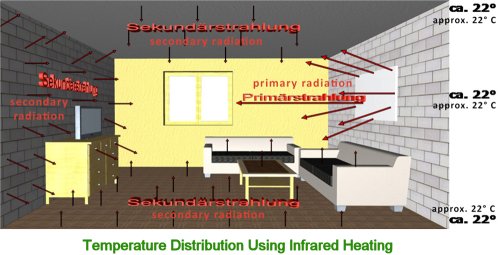 Infrared works in temperatures of +40C down to -50C, unlike heat pumps that will struggle once the outside temperature drops below 5C. Heat pumps will need additional help to keep the property warm enough for residents, and apparently in winter need to be running 24/7. Infrared does not need any backup to provide the heat needed.
Infrared works in temperatures of +40C down to -50C, unlike heat pumps that will struggle once the outside temperature drops below 5C. Heat pumps will need additional help to keep the property warm enough for residents, and apparently in winter need to be running 24/7. Infrared does not need any backup to provide the heat needed.
The top diagram shows how infrared heats the walls and all objects in the room. The heat is absorbed and then reflected back into the room, giving a comfortable all-round ambience. The heat will also stay longer in the room, even after being turned off. The bottom diagram shows the same room with convection heat. Both diagrams show the heating paths and comparative temperatures at the ceiling, middle and floor of the room.
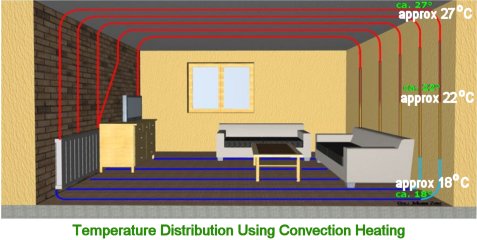 Infrared heating does not need extra ventilation as the heat does not dry the air. With convection heat through radiators the air is heated but the walls stay cold, potentially causing condensation. With underfloor heating the rising heat pushes up dust and children up to the height of 1.2 metres may develop asthma, which is already quite common in children.
Infrared heating does not need extra ventilation as the heat does not dry the air. With convection heat through radiators the air is heated but the walls stay cold, potentially causing condensation. With underfloor heating the rising heat pushes up dust and children up to the height of 1.2 metres may develop asthma, which is already quite common in children.
When a room is heated without using IR it heats the air in the room and not the objects. This means that the walls remain cold and when the air reaches them and is sufficiently warm it will create condensation, which in turn can turn to damp and mould in the room. This assumes that the room is not ventilated; if ventilated it would then make the room more expensive to heat.
IR does not dry the air or create humidity in the room and therefore does not need extra ventilation.
When the temperature is -20 degrees C outside can the temperature inside stay at say 24 degrees C
That is no problem when the room has the correct panel wattage. The higher the desired temperature the longer the panels will run.
This is why it is important to use the correct wattage of panel(s) for the room size. If insufficient wattage is installed the panels will run for longer trying to reach the required temperature and will therefore cost more to run. We are always available to specify the correct wattage required for your premises, which is a free and necessary service.
How does the Thermostat know the temperature in each room? Can it turn off heat when not required in any room
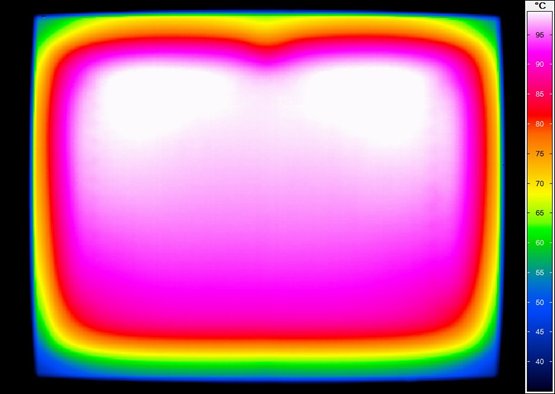 The diagram to the left shows the even heat distribution of Infrared heating with our Heat4All panels
The diagram to the left shows the even heat distribution of Infrared heating with our Heat4All panels
The Heat4All controls. A thermostat can only measure the temperature in the room where it is located. If you use only one thermostat for your whole home and you locate the thermostat in the living room, the thermostat will switch off all panels in your apartment when the set temperature of the living room is reached. So, it can happen that you will reach the set temperature of 21 degrees in the living room and you will have only 16 degrees in the bath room. So normally 99% of our clients who build a new apartment or make a full renovation of their home take a room thermostat (BT710 H4A Wireless Thermostat) for each room and a BT001 (Heat4All Flush-Mounted Switch Actuator) per panel.
They will then install a socket outlet with electricity on the ceiling behind each panel. The BT001 (Heat4All Flush-Mounted Switch Actuator) will then be put into the empty socket and will be connected with the panel and the electricity according to the diagram enclosed with each panel. All of the available controls can be seen here.
The Thermostat (BT710) and the Actuator (BT001) will then communicate wirelessly.
Can the thermostat be controlled by an app
The HomeMatic System
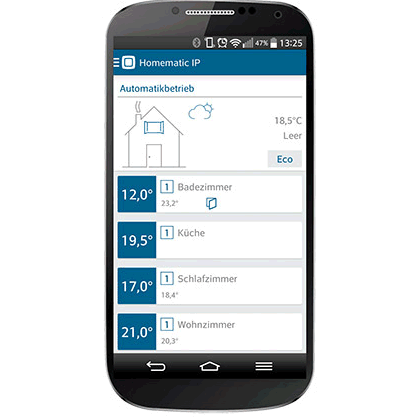 Yes, we have also an internet-based thermostat system in our portfolio, the so called Homematic system, which is shown on the Controls page. This system is from a German company. The HomeMatic uses a Central Hub to control all the panels in the building. Every panel is fitted with its own thermostat and actuator, which communicate with the Hub and control each room individually.
Yes, we have also an internet-based thermostat system in our portfolio, the so called Homematic system, which is shown on the Controls page. This system is from a German company. The HomeMatic uses a Central Hub to control all the panels in the building. Every panel is fitted with its own thermostat and actuator, which communicate with the Hub and control each room individually.
The advantage of the Homematic system is that you will have an App on your mobile phone or laptop and you can always access your heating system. Whenever you have internet connection you will be able to see the current temperature of each room, the humidity and if the heater is on or off. You can always change the temperatures separately for each room as well as the time programming.
It is an inexpensive system when compared to other systems like Siemens or Eaton. Other comparable systems normally cost more than double.
If preferred the HomeMatic can be integrated into a Nest, Hive or other similar system.
Costs
A major advantage of infrared over any other form of heating is the cost of purchase. Infrared is between one fifth and one eighth of the cost of an air source heat pump, ASHPs having to have additional insulation to work efficiently. It is one twentieth of the cost of a ground source heat pump. In round figures a four bedroomed house can have infrared installed for around £2,000 based on volume. Further to that there is no maintenance so on current terms there is a saving of at least £160 per year. Additionally, infrared will last up to 40 years without the need to replace.
It seems that modern life is now lived in the kitchen/diner and at night the bedroom. Those rooms are therefore the only rooms you need to heat, other than to air rooms in the winter.
To give an example of how to use a 'Smart' way of heating your home, there are three scenarios below:-
The below calculations are made using this formula -
Hours usage per day x Heating days p.a. x (wattage / 1000) x Price per KWh.
The variables, including Hours usage per day and Heating days per annum, can be changed to suit your own needs. Add the Daily Standing Charge for the total cost.
The average Price per KWh = £0.28, Standing charge per day = £0.40.
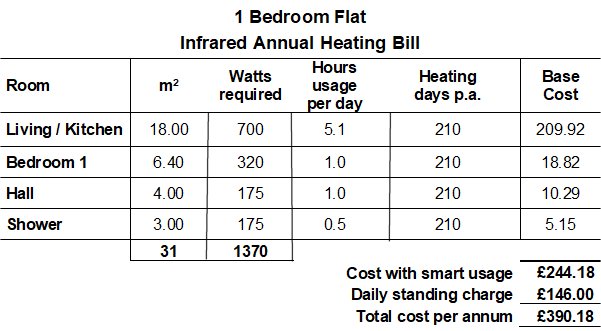
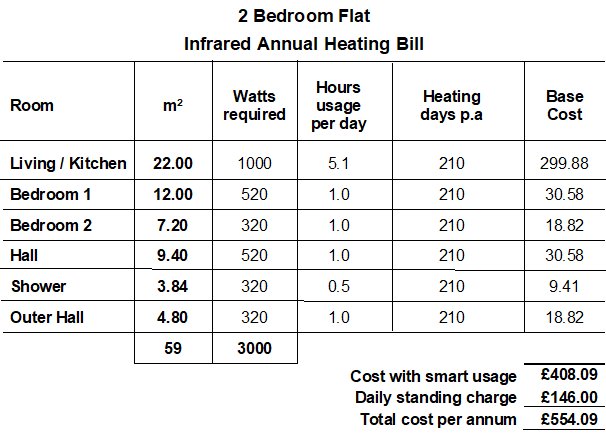
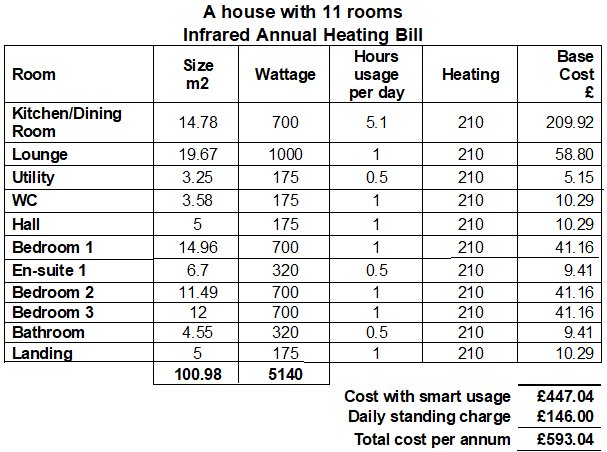
U-values in relation to air changes in a room
Air changes in a room do not impact our infrared heating system in the same way as all other conventional heating systems. We are not directly heating up the air but the walls, floors, ceilings and all other objects in the room like furniture. So, if you let cold air in and you close the window you will still feel it warm when using our infrared heating system, as a human being you will feel the temperature of the surrounding walls, floors or ceilings and not the air temperature. With a conventional heating system, you have to heat up all the air for it to feel warm at the floor again. For example, when you have a warm summer and the infrared waves of the sum have heated up your walls and floors, you can open the window on a colder day and let cold air in, but when closing the window you will have cold air in the room, but you will feel it still warm, because you feel the warmth from the walls and floors. So, you can see that air changes will not really impact the infrared heating system.
Much more important is the U-value of your home. The better your home is insulated, the longer the walls will stay warm. Bad insulation means that the walls become cooler more quickly and the infrared panels have to run longer to keep the wall warm than in a home with good insulation.
U-values influence the wattage. Our calculations are for new build houses with normal insulation. We normally we calculate slightly higher wattages, to be on the safe side. Our experience shows that the higher the wattage the lower the heating bill will be. A larger panel runs much less hours than a smaller panel and overall will be less costly. If you underestimate the wattage the room will not become as warm as you would probably like. The U-values have some influence on the dimensioning of the infrared heating, but not so much as with a conventional heating system with radiators.
The best way to explain this is with an example:-
We have two properties A and B; each one has a living room of 20m2 and a bath room of 6m2 and both have the same good U-value. The living room in property A has two windows with normal sizes, wooden floors or parquet floors and a lot of wooden furniture. In this case we will need 35Watt/m2, so a total of 700 Watt.
The living room in property B has to complete glass walls, tiled floors, and some furniture from glass, like a glass-topped table, or cupboards with glass fronts. In this case we would need 50Watt/m2, so a total of 1000 Watt.
The bathroom in property A has a floor of dark virgin stone, no tiled walls, a small mirror and some wooden furniture. In this case we will need 45 watts/m2, so a total of 260 watts.
The bathroom in property A has a tiled floor, tiled walls, a larger mirror and a lot of ceramic furniture. In this case we will need 60 watts/m2, so a total of 360 watts.
As you can see with these examples, the wattages are not only influenced by the U-value but also by the materials in the rooms, as some materials store more infrared waves and some less. Our calculations are always based on the worst situation, so that we can be sure that each room becomes warm enough. The advantage is that when you have a lot of materials which store a lot of infrared waves, the heaters will be working less and the heating bill will be lower.
Interesting facts about Infrared Heat
The German born British astronomer, Friedrich Wilhelm Herschel, discovered infrared rays when testing the differing temperatures of coloured light through a prism. Further experimenting led to his conclusion that there was an invisible form of light beyond the red end of the visible spectrum that gave out more heat.
Heat4All Infrared heaters send out 99,9% infrared C-waves, the same C-waves as a tiled stove. Infrared C-waves are never unhealthy as they only touch the surface of the skin, as do the waves of a tiled stove.
Infrared C-waves are different from UV-waves (ultraviolet waves) of the sun, which are unhealthy when overused. Solar radiation is made up in two parts - almost 50% of the radiation that reaches earth is infrared radiation, which is responsible for the feeling of warmth when standing in the sun. The other part of the radiation is the harmful UV rays.
Furthermore, it is necessary to differentiate between infrared A, B, and C-waves.
Infrared C-waves as described are only touching the skin, infrared B-waves (e.g. typical outdoor heater with glowing heating rod) are going slightly under the skin and therefore they are not so comfortable for a person.
Infrared A-waves, e.g. sent out by an infrared sauna or by a red light lamp used for health reasons, are going deeper under the skin and therefore you should only be exposed to them for no longer than 20 - 25 minutes.
Ceiling mounting
The distance of the front plate from the ceiling will be 36mm. Regarding the efficiency there will be not be a big difference if the panel is on the ceiling or on the walls if it is a smaller room. The efficiency is higher the shorter the distance before the infrared waves touch the surfaces they heat up. When the panel is on the ceiling most waves will touch the floor after 2.60m. When it is a small room 2.5 by 2.5m most of the waves will the touch the opposite wall after 2.50m. The opposite cannot be a glass front, like windows or mirrors, because the waves will pass through the glass and the distance will double until the waves touch the surface they heat up.
In a large room, i.e. 8m x 8m, the only efficient usage is to put the panel on the ceiling.
Another advantage with a ceiling mounting is that all the walls are clear so that pictures or furniture can be placed by choice.
The panels may be put on the walls if it is preferred but the size and shape of the room must be taken into account.